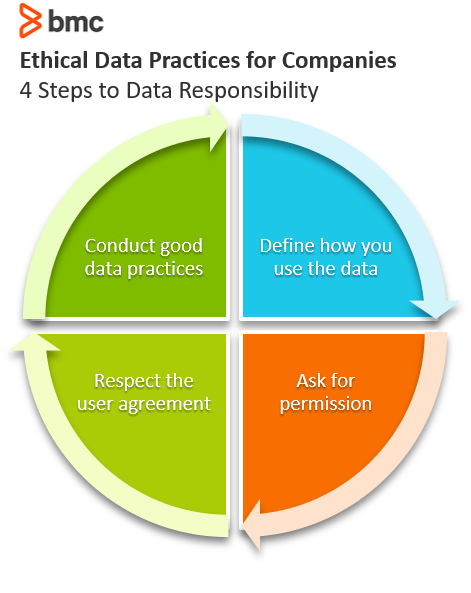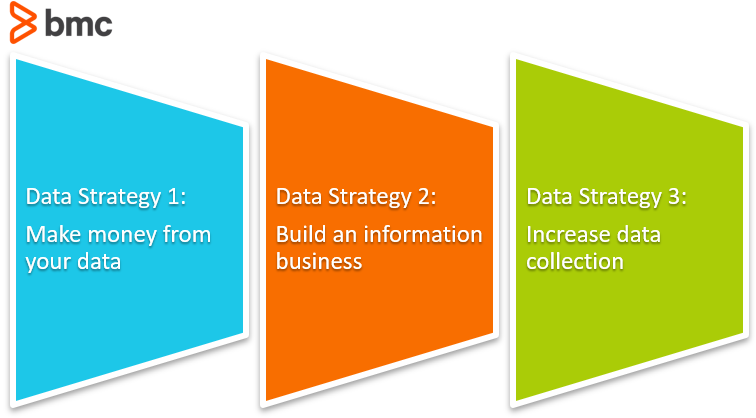Companies define how to get, give, and use data in data strategies.
In this article, I will:
- Explain a data strategy and what makes a good one
- Explore three simple strategies that companies can use for data
- Consider factors in any data strategy
Importantly, the strategies in this article align closely with the ethics and data responsibilities that companies have.

What is a data strategy?
Data strategies describe how a business is to get, give, and use data in the world.
Your data strategy consider how data is used at the business level to make money for the business. Creating and following your data strategy often involves expanding the existing product line of a business, ultimately to affect the bottom line.
A good data strategy can explain:
- Why the data is collected
- What it is used for
- Who will benefit
Typically, the measure for success is that the data strategy can increase profits. Whether it is through increasing user engagement, offering more direct product offerings, or increasing the relationship between current or new users, at the end of the day, all these items contribute to the company’s profitability and its ability to work another day.
Any good data strategy will have:
- A clear purpose
- Measurements of success (including timeframes)
- Reasons for why these measures are significant
Now, what exactly will you do with your data? Here are three common, simple strategies for businesses to explore.
Strategy 1: Make money from your data
This strategy is all about making money from your data. Moving from using data for cost-cutting strategies to letting the data earn income. This strategy opens your mind to considering how you can use the data you collect, or will collect, to earn income.
You’ll want to consider several angles to make this strategy feasible.
Providing benefits to the consumers
How can you expose the data analytics your data scientists are using to the consumer in ways that are tangibly beneficial to them?
An easy place to start is with the data scientists. They are already interacting with company datasets regularly, so start with them. The data scientists may have ideas about how the data they are working with can be beneficial directly to the customers.
Creating a premium option for consumers
Are there ways you can monetize the information and charge a premium fee for customers to access the data?
Maybe you sit on lots of data about consumer behavior that the consumer would like to know, or maybe the consumer could know and deliver to the people they work with.
Maybe there is an incredible photo dataset that has grown over the years that could be combined with image detection and turned into an API endpoint for customers to work with.
To determine which data you can monetize, you will need to look at the data that is sitting around in warehouses and lakes. Talk to the data scientists who interact with it on a daily basis to drive cost-cutting initiatives and see how the data could be used or transformed into something consumable by a customer.
Finding new consumers
Given the data your company has collected, can you start new relationships with other customers?
Maybe you uniquely have lots of data in one particular area. This data may benefit researchers or universities, or it can be used by larger analytics companies.
If you don’t have this data yet, but have the relationships, then maybe it’s possible to start collecting the data now—in 3-5 years, perhaps sooner, you can then monetize those relationships.

Strategy 2: Build an information business
If possible, pivot your business model towards an information business. In this strategy, the value of your company is the information that you have. You could:
- Expose the data
- Create textbooks and research studies
- Offer the data to research institutions
In this strategy, customers come to your company for any information regarding your industry.
Google is largely centered around giving information to people. It’s at the center of its mission statement:
“Our company mission is to organize the world’s information and make it universally accessible and useful.”
The goal is not to be Google (good luck), but to see how information within your organization can be valuable to people. Information in the world exists in silos, and Google by nature does not have access to the world’s information. There is plenty of room within the world for your company’s corner to find a way to offer value.
Ways to start the information business:
- Create a searchable database
- Build and offer external/internal APIs
- Develop Wiki pages, like a Wikipedia for your industry
- Publish quarterly reports, like Farmers’ Almanac or industry reports from Gartner or Forrester
When knowledge is power, consider:
- The things your organization has and knows
- The other people in the world who might want to know it
Strategy 3: Increase data collection
Increasing data collection is two-fold:
- Increase activities where you can collect data.
- Increase the amount of data you collect on current business activities.
To have data to offer, data collection is essential. So, how your organization gets, stores, and uses its data is a huge part of a strategy.
There is a huge caveat with this strategy, though. Data collection is limited by what is asked of people. People have their limits.
Go digital
First, go digital. Wherever it is possible to go digital, go digital. Wherever there is paper, change to Word documents and filestore systems. Use online signing agreements. Place digital devices in people’s hands.
Toll booths should have a sensor that counts all the traffic passing through—instead of relying on loose quarters and a human sitting and logging each car that passes through. Apply this kind of thinking wherever possible in the company. Just go digital.
Digital sensors, cloud storage, and computers and IoT devices allow data to be collected where none was before. Then, how your system matures will depend on the ease of data collection: Manual inputs can collect structured data. Digital devices, though, are the only way to collect raw data inputs for unstructured data, especially for large-scale collection.
(Understand how structured and unstructured data work.)
Make data inputting seamless or automatic
As long as data is easy to add and store, you can collect more of it.
Students can only go so far with the data they add to their paper if they already have to write the title, name, date, and class. Time, and care, only permits so much data to be entered. Some of these items can be automated, allowing for more data to be collected on class assignments like time of day, how much sleep they got, and how they are feeling that day.
Especially with data collection, remember our caveat: humans have limits.
Consider what data collection you can automate in a way that does not push peoples’ limits yet still allows for more data collection.
(See why automating data ingestion is an essential practice.)
Considering a data strategy
Choosing a data strategy might seem easy, but don’t forget about the additional considerations.
Data for the future
Is it possible for your business to think about the data for the future?
- What data do you need to offer the value you want to offer?
- Can you store data?
- How can you store data?
- Do you need to easily upgrade storage?
- Does your data need to be transferable?
Data infrastructure
How do you access and work with the data?
- Internal and external APIs
- Data storage
- Data pipelines
While data strategy is a high-level business concept, it is likely engineers and IT guys will need to be included in the conversation so the data strategy can be grounded to what is actually feasible from an engineering and a financial side.
(Is your data strategy defensive, offensive, or well-balanced? Thomas Davenport in the Harvard Business Review covers this topic.)







